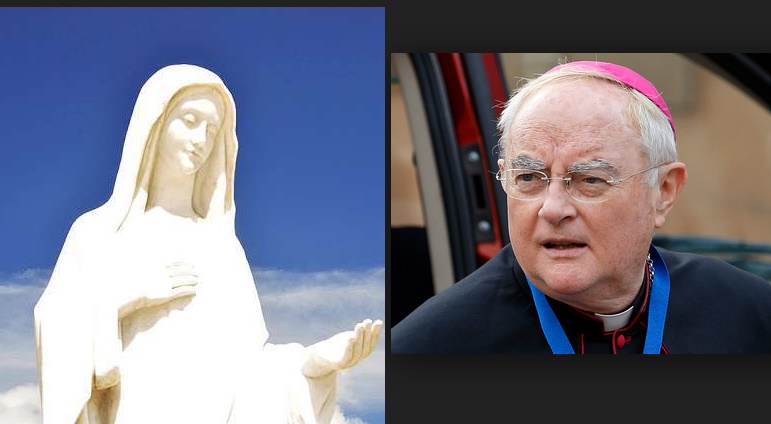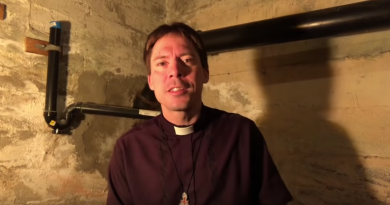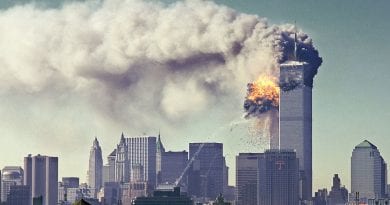New Powerful and Important Interview with Papal Envoy to Medjugorje Archbishop Hoser – “Yes, Medjugorje has officially come out of isolation…This is obviously a great sign of confirmation of the good and right path on which Medjugorje is moving.”
Let us remember only the fundamental right to life, which is being relativized in a dictatorial way today, and which is the first and supreme human right above all other rights, because every human being depends on life, on existence. Today we are witnessing the relativization of life in which a person qualifies as useful or useless. Those marked as useless are removed from society. Such a cultural revolution underlies all dictatorships such as Italian fascism, German Nazism or Soviet communism. In principle, it is the idea of creating a new man not in a biblical and theological sense that is shaped in relation to God, but a man who is shaped in relation to the imposed ideology.
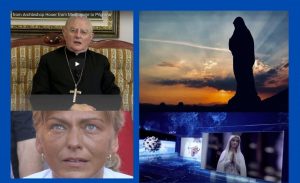
Your Excellency, first of all I would like to thank you for your patience and time for this conversation. The corona virus pandemic that struck us at the beginning of the year exposed the misconceptions about the globalized world. The world, which until yesterday was rushing with a lot of noise towards the supposedly unprecedented progress, suddenly proved to be weak and vulnerable.
Exactly! The pandemic did not reveal the strength and unity of this world but its weakness and division. It has shown our helplessness and paralyzed all the activities of modern society on an economic, communication, social and political level, which is characteristic of a catastrophe in which we notice that we are not omnipotent and have no dominance over this world. It is a sign that needs to be read because we as Christians are called to recognize the signs of the times. This is therefore a great sign of the times which has, I dare say, an apocalyptic nature which is opposed to our limitations of action and the possibility of renewal because it transcends us in the face of cosmic and biological forces.
We live in a time of dictatorship of relativism that recognizes nothing as definite and recognizes no goal other than ego and self-desires. Pope Benedict XVI said on one occasion: “Relativism is proving to be the only position that suits today’s times.” Such a culture considers us Christians to be fundamentalists and extremists. How can we stay true to the Faith and be free?
The dictatorship of relativism is a term introduced by Pope Benedict XVI. It is a phenomenon that ultimately destroys our social fabric because it deprives us of everything that is stable, that represents our foundations and roots, that is timeless, that is, everything that is forever verified and valid through generations. All reference components are now relativized. It also means a change in our perception of reality that results from the denial of the existence of objective truth. We have now become slaves to our personal truths. Everyone has their own truth and everyone considers their truth universal, which is why the existence of one truth is denied. On this phenomenon, Pope John Paul II reacted with an encyclical entitled Veritatis Splendor ( The Splendor of Truth) in which he defends the existence of a universal and objective truth which is equal for every man and whose name refers to the fundamental measure of truth. Thus the dictatorship of relativism is an instrument of action by which man is deprived of the opportunity to acquire his freedom. Jesus said that truth liberates man, which is universal freedom, while the dictatorship of relativism imposes partial freedoms that are in line with the ruling forces in the world, with those who want to create a globalized world but globalized only at the level of profit.
 We are in a crisis where man loses joy and enthusiasm because his dignity is stifled in the process of developing technology and the economy of inequality and exclusion. How to get out of this crisis?
We are in a crisis where man loses joy and enthusiasm because his dignity is stifled in the process of developing technology and the economy of inequality and exclusion. How to get out of this crisis?This question is very difficult to answer because so much needs to change, to find all that we have lost. It is clear that we are subject to determinants, some of which are secondary but which serve the ruling forces. Thus, technological and economic desires begin to rule us, stifle us, and make of us helpful people deprived of their inner freedom of spirit, which imposes sorrow and fear. We should rebuild, rebuild. Every man must find his identity and objectivity, but also his effectiveness. All people are equal to each other, and today that is exactly what is denied, the one and only human nature. This last indication that we are all human, that we share the same human nature is forgotten today because the emphasis is on culture. But culture does not exist, as nature does. There are only cultures, in the plural, such as national, personal and all others. Therefore, there are cultural differences all over the world, but we miss what unites us, which means that we distance ourselves from each other. It is a very critical moment in which we must return to what is fundamental, what shapes our universal human identity. Such a situation will have inevitable consequences in the future because in the new culture man becomes a model of man, and a damaged model. For us believers, God is the measure of our humanity, especially Jesus Christ who is the model of the true man. In our resemblance to God we must find in ourselves the qualities by which we are like Him. This resemblance is not limited to mercy or individual faculties such as reason or will, but also implies the ability to create interrelationships, because God also exists in a triune relationship. Therefore, we too have a duty to create true relationships with one another in order to achieve a resemblance to God, a relationship that strives for unity that will prevent dispersal and alienation.
 Wrapped in an alleged struggle for ‘human rights’, a cultural revolution is taking place on the world stage that is slowly turning into open totalitarianism.
Wrapped in an alleged struggle for ‘human rights’, a cultural revolution is taking place on the world stage that is slowly turning into open totalitarianism.The cultural revolution in the end always has a Marxist character. Let us recall, for example, the cultural revolution in China, which sought to break with Chinese tradition and secular culture and create a new man in the Soviet style. Today we have dominant neo-Marxist currents that also seek to create a new, different man who breaks with his past, identity and values that have been valid for centuries and that are passed on unchanged to generations such as fundamental human and other rights which are changing today. Let us remember only the fundamental right to life, which is being relativized in a dictatorial way today, and which is the first and supreme human right above all other rights, because every human being depends on life, on existence. Today we are witnessing the relativization of life in which a person qualifies as useful or useless. Those marked as useless are removed from society. Such a cultural revolution underlies all dictatorships such as Italian fascism, German Nazism or Soviet communism. In principle, it is the idea of creating a new man not in a biblical and theological sense that is shaped in relation to God, but a man who is shaped in relation to the imposed ideology.
In these times a ruthless war is being waged against the body, against man, against the dignity of the human person, against life. Day by day we are witnessing perfidious attacks on fundamental truths about man.
Behind everything is obviously the Marxist ideology, but – as I explained in another conversation – it is an ideology of a new class struggle that takes place at the level of the biological sex, that is, man and woman. God created us as men and women, and that is denied today. In addition, we no longer accept the gifts we have received. These are biological determinants that we reject and advocate for sociocultural gender. Thus, intellectual deviance and paranoid complexes occur because some may declare themselves as women or men without contradicting what is obvious. The new man who ultimately denies his original identity and who imposes himself in it becomes extremely unstable because they are two different identities. It is at this level that a very deep and powerful cultural revolution is taking place.
The words of the Fatima seer Lucia echo all the ominous words that the last battle for man will be fought through the family.
The family is the fundamental community, the core of society, the first school of human socialization in which we learn to create relationships with others. It is based on the relationship within the family, between parents and children. The family is also the reality of married life and the unity in diversity that is achieved fundamentally. The family can be considered an icon of earthly holiness. But in today’s world, it is in the family that we notice the motives of the Evil One. Sister Lucia warned us about that. Today, the family is trying to be destroyed because the natural family, not just the sacramental one, ensures fidelity to life, when we talk about spouses, parents and children. The global process seeks to destroy a society in which man is deprived of the relationships that determine him, which role he represents and what binds us. Today, anyone can say that he wants to live a certain kind of freedom that frees him from all determinants and that makes him mobile and ready for change. In this way, anyone can change into a woman or a man and this will be considered the realization of personal freedom in terms of our contemporary post-Christian culture.
By introducing gender ideology into all segments of society, is it trying to redefine the very anthropology of man?
Yes! It is precisely the anthropological redefinition of man himself. We have moved from the period of postmodernism and post-nationalism to a period called transhumanism. This means that there is a need to cross the boundaries of what is human and “transgression”, ie remove the restrictions. We are currently in an advanced stage of posthumanism. Man must function as a hybrid, partly a hybrid of a biological mechanism, but increasingly also by integrating a technological process that is implanted in the human being itself. The lie is that it liberates us, but ultimately it makes us slaves.
Today, the role of women and their equality is being debated around the world. And the role of women in the Church is becoming an increasingly topical issue. How does the Church really view the role and mission of women today? Men are also women, togetherness in diversity. Is that really the case?
The identity of a woman is most visible and best defined from a biblical point of view and our Christian faith. We recognize that man and woman are equal in their human dignity. These are the same beings in their essence, but with respect for their anatomical, physiological, psychological, but also spiritual differences. The spirituality of man and woman is different. Examples include St. Paul and St. Teresa of the Child Jesus.
Didn’t the feminist movement that dominates today’s society actually ensnare the modern woman by making her a slave to false idols?
It is true that modern society nullifies the differences between men and women that need to be respected, which is influenced by the feminist movement, which is also a kind of Marxism and which also introduces class struggle. It is a struggle between men and women. The feminist ideal seeks to appropriate all male privileges and traits and thus remove men to whom a supporting role belongs. It is women who want to dominate, and women with masculine traits who, for example, engage in aggressive male sports that are otherwise repulsive to normal women. Martial arts have always been reserved for men because they show the strength that comes from their physical characteristics that are the result of these biological differences. Also prominent today is feminism, which at the same time imposes a denial of motherhood. These are women who do not want to start a family or have children because they despise such values, because they enjoy living in the intersex and other relationships they want to have. It is forgotten that a woman’s calling is imposed in itself by her capacity for motherhood. A woman is not only a wife but also a mother. She is the bearer of life. Society should ensure to every woman her self-realization as a mother because without it there is no succession of generations. It is very characteristic of European and North American countries that fertility declines over time, which is why there is no replacement of generations, which is the result of the professionalization of women who are forced to be just as effective in corporations as men. Therefore, their right to family life is not recognized. In some countries, family life is also considered a profession, which is fundamental to survival of one society.
Where should today’s women and men look for a role model?
A woman should be where a man cannot replace her as such. Female motherhood in itself imposes the need for protection by men. He needs to protect her, bring her the help she needs. Two models of masculinity are: St. Joseph and Jesus Christ. We also have a model of femininity: the Virgin Mary who was also a mother. It is especially striking to me that the great writers of Our Lady are always men: St. Louis de Montfort, St. Maximilian Kolbe, and St. John Paul II, while women such are Saint Margaret Mary Alacoque, Saint Faustina, and many others are at the forefront of devotion to Jesus Christ.
Does the Church sufficiently listen to the needs of a person today and how and to what extent does it act?
The Church listens very carefully. It is enough to read the papal teachings, for example of Paul VI, John Paul II, Benedict XVI, and Pope Francis, to notice that there are always reactions to the current state of the world. I am just reading in detail the Pope’s last encyclical Fratelli tutti (We are all brothers) in which he makes an extraordinary diagnosis of today’s world. The problem arises when pastoral values do not reach people, because our sermons generally go unnoticed and are quickly forgotten because one gets the impression that the same things are being repeated. In this sense, respect for catechetical values is important, but not enough. The Church is the mother who teaches her children, she is the Mater et magistra (Mother and Teacher) and as such should play her role, as spoken in the said encyclical which is in this sense the most convincing and constant. But there is also the synod’s petition of Pope Francis Christus vivit (Christ lives) which is intended for young people in today’s world and others. So, the media like the Messenger of Peace should do everything to present what the Church teaches in order to reach people, about how the Church reads what is happening and what surrounds us – all phenomena and everything that is happening. In that sense, we need to work together.
Today, more than ever, the Church should bear witness to the faith in Jesus Christ with her life. Is the Church in crisis today and is it taking on, especially the Church in the West, the spirit of this time?
This crisis did not begin today, but appeared immediately after the second Vatican Council, exactly in 1968 after the publication of the encyclical Humanae Vitae (Human Life) when the Western bishops unfortunately expressed their disagreement. From that moment on, challenging papal teachings became the rule in the West, as in Germany, France, Switzerland, and elsewhere. What Paul VI challenged was disputed. The Pope represents the authority, but in the West, his authority was not respected.. Everyone has their own truth, authority and role model built according to individual rules. We have seen Pope John Paul II calm that storm with his long pontificate. Yet today we are in the second wave of the conciliar crisis in the Western Church.
What is the role of young people in today’s world?
The role of young people is important, although it should be emphasized that adolescence is a transient phase of life. They are not young all their lives and when they grow up, today’s young people will shape the world in their own way with their ideas. If young people have not received the right upbringing, humanity is in danger of disappearing. One fact that you also mentioned should be pointed out here, and that is the problem of media lynching. Today’s young people are becoming media products in which partial information arouses a lot of emotions. It is not about the usual emotions caused by distinguishing between good and evil. Therefore, young people cannot build a solid foundation. They shape uncoordinated ideas in which they lack wisdom. Thus, what characterizes new generations is the absence of the possibility of cognition and true values. They lack freedom because they are addicted to various media devices, literally glued to their cell phones and computers from a young age. They lose the ability to remember valuable information. All the information that interests them happens in one hour and is temporarily served on various servers, which causes them to lose their internal structure and ability to learn continuously.
The more the universal truth is relativized, the more one gets the impression that young people are looking for it.
Yes, they are looking for the truth, but they do not find authorities they can trust. Their authorities may be media stars, but their true authority was annulled after the 1968 revolution, which was directed against everything that was truly valuable. The problem now is that young people have a wide range of possible choices, but they lack selection criteria. They can’t tell what’s good and what’s bad, what’s bearing long-term fruit, what’s bearing fruit at all, and so on.
Isn’t Mladifest the best example of sincere young seekers?
Yes, Mladifest is good an example because the youth are looking for change and in their search, they gather in a very wide community of tens of thousands from all over the world to sing songs and express their faith in the same way, but disperse again to their homes. So this idea that John Paul II began of world youth day gatherings is great, but it is only a minority of the total number of young people. Yet even this minority can make a difference around themselves in their communities and show that there are still zones of healthy youth.
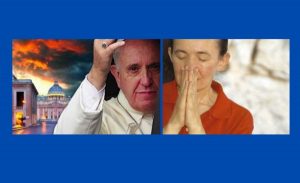 Pope Francis has appointed you as special envoy and then as apostolic visitor to the Holy See for Medjugorje. Enough time has passed for you to form a clearer picture of everything that happened and is happening in Medjugorje. Can you briefly convey your impressions to our readers? What is Medjugorje for you?
Pope Francis has appointed you as special envoy and then as apostolic visitor to the Holy See for Medjugorje. Enough time has passed for you to form a clearer picture of everything that happened and is happening in Medjugorje. Can you briefly convey your impressions to our readers? What is Medjugorje for you?
Officially, Medjugorje is one parish, the parish of St. James, without additional terminology. It is neither a diocesan nor a state nor an international shrine. Medjugorje is looking for itself. It has been 40 years since the beginning of the Medjugorje phenomenon, during which a certain physiognomy of Medjugorje was formed. In essence, this is a place that does not cross the borders of one village, but which is known all over the world, which is a phenomenon in itself. Medjugorje truly, although without an official name, has the dimension of an international sanctuary. A big problem for Medjugorje is the still undefined situation regarding Our Lady’s apparitions. Discussions have been going on for a long time between a large number of supporters and opponents, which creates a conflict that has been developing for 40 years and which is the basis of the cautious attitude taken by the Holy See. But slowly, in small steps, progress is made towards correct discernment. I believe that one stage in this is my appointment as an apostolic visitor, which opens up the possibility of accessing and supervising the correct practice of piety, which is very important. Finally, this year Pope Francis sent a message to the young people gathered at the Youth Festival. These are all small but important steps that seek to normalize the situation here. But we have to be patient.
Pope Paul VI published the Apostolic Exhortation Marialis Cultus after the Vatican Council, in which he refers to correct and healthy devotion to Mary. Was the Marian devotion you found here in accordance with the guidelines of the Church?
The Gospel criterion of a fruit-bearing tree that is indisputably positive can be applied to Medjugorje. We are witnessing a huge number of pilgrims, the extraordinary phenomenon of conversion, inner healing, etc. A large number of people come here in search of what they have lost, such as a sense of holiness, prayer, adoration, and what is offered to them in Medjugorje with a lot good fruits. In addition, Marian Christocentric devotion is confirmed here, Mary as the mother of Jesus Christ, who is at the foot of the Cross, which points to the proper veneration of the Virgin Mary spoken of by Pope Paul VI in Marialis Cultus, which is also found in the eighth chapter of the constitution of Vatican Council II, Lumen Gentium. This passage points to the place of the Blessed Virgin Mary in the history of salvation and in the life of the Church. Everything that happens in Medjugorje is in accordance with the norms of veneration written in the Marialis Cultus. I would dare to say that it is obvious that Medjugorje today offers a model of new evangelization that teaches us to turn to the example of the Church, as well as the way of life of Christians who should be active in the Church and who should live the grace of consecration. ecclesiam nulla salus (There is no salvation outside the Church).
Father Archbishop, you come from a nation that is in many ways similar to us Croats and in which Marian piety is also strongly present. What does the Blessed Virgin mean for your faith and spirituality?
I have been shaped by Marian devotion since childhood. I have always been under the protection of the mantle of the Blessed Virgin Mary who of course guided me towards Jesus Christ. She is also the spiritual mother of my priesthood. I am in a kind of communion with the Virgin Mary because she is at the center of my devotion. As a man, it’s easier for me to accomplish that than it might be for a woman. I am happy to see what the Virgin Mary is doing for us to progress and how she is succeeding. Today she appears as a woman from Revelation who fights against an evil spirit who has been set free, because everything that happens in today’s world, and what we have talked about, is inspired by the forces of darkness. The specialty of the Evil One is the introduction of divisions and condemnations, which means that the culture of hatred inflicts evil on us for all that we do good.
You once said that Our Lady’s apparitions in Medjugorje are significantly different from the previous ones. What is specifically different here from other shrines?
Each place of Marian devotion has its own special atmosphere. People who come here keep telling me that there is a special silence and peace here. That’s what I can clearly feel. I cannot feel such silence and peace elsewhere in the world. There is no silence because we are immersed in noise, and there is also no peace, neither in families nor in nations nor among nations in the whole world because conflicts reign. In addition, it is obvious that proper worship is taught here. People here feel enlightened also because of the locals. Here we meet believers who pray in the family unit, a custom that has disappeared everywhere. There are currently no pilgrims, but the church is always full as early as six in the morning. There is a strong line of transmission of the traditional faith among the locals, which is a challenge for pilgrims who come here. Parishioners transmit an authentic faith that the pilgrims notice and it builds up the pilgrims in their contacts with the locals during their stay.
Here pilgrims encounter some practices and devotions which, unfortunately, have almost disappeared in Western Europe. In addition to the piety of adoration before the Blessed Sacrament, the devotion of the Way of the Cross, there is a particularly strong practice of confessing ones sins in the Sacrament of Confession.
The sacramental practice of confession is a great peculiarity of Medjugorje. Nowhere in the world is there so much confession as here, not even in great shrines like Fatima. Here confession for the pilgrims represents great grace and novelty, a sacrament they rediscover.
After Pope Francis allowed the organization of official pilgrimages, pilgrimages can now be organized not only by priests, but also by bishops and cardinals, and here Mass can be celebrated in a solemn and public manner. Is this a sign that Medjugorje has come out of a kind of exile?
Yes, Medjugorje has officially come out of isolation. We had the opportunity here last year to meet cardinals and other high church officials from Rome and other places, such as Cardinal De Donatis and Archbishop Fisichella. This is obviously a great sign of confirmation of the good and right path on which Medjugorje is moving.
The Commission for Medjugorje, headed by Cardinal Ruini, gave a positive opinion on the authenticity of the first apparitions between June 24 and July 3, 1981. In 2017, for the Polish Catholic News Agency (KPA), you made the following statement: “Specifically, the recognition of the first seven apparitions is possible, as proposed by the commission of Cardinal Carmillo Ruini.
I cannot comment on Cardinal Ruini’s report because I have not had a chance to read it. The news was self-reported by the Italian media. It is said that there is a possibility of acknowledging the first seven days of the apparitions, but there are also more than 40,000 individual apparitions that continue on. But what is characteristic of the first apparitions is that all the seers were together, which provides an opportunity to verify the cross-testimonies. Now all the visionaries are in different places.
Does this report call into question everything that has happened after these first apparitions to the present day?
I repeat, I have not had the opportunity to read Cardinal Ruini’s report. Apparitions are analyzed, but they are recurring phenomena that remind of what has already been said, which classifies them as a kind of “additional” apparitions. I must point out that I personally do not comment on the apparitions.
Have you met the visionaries? What impression did the visionaries leave on you?
Yes, I met the seers twice, the ones who were here. The first time was in 2017 before taking office, and the second time recently. I did not want to meet them for apparitions but simply as part of my pastoral ministry to meet them. Each of them lives a family and Christian life. My impression is that they are very nice, family, ordinary people.
In one message here Our Lady said that she had come to continue the work she had begun in Fatima.
It is possible to look at the phenomenon from that point of view, but La Salette, for example, has the same apocalyptic character where the future is predicted and where we are warned of the need to convert in order to avoid adversity. In Fatima, this was very strong in 1917, during the Soviet Revolution, the end of World War I, which took many victims even before World War II, a world war that broke out because people obviously didn’t convert. We are now also in danger of large-scale conflict.
Can we say that apparitions are always Heaven’s response to the needs of the Earth?
Of course, this is an update of the Revelation of Jesus Christ found in the Gospels. Also, the Revelation of St. John speaks of what we are witnessing today. Therefore, certain events are predicted in Fatima, Kibeho and other places of apparitions. Our Lady addresses us to warn us to be careful because otherwise we will all perish.
Where do you see Medjugorje in the new evangelization that the Church emphasizes so much?
I would like to emphasize that Medjugorje is an example of a new evangelization, which refers to the need to find what we have lost. The other thing is the ability to read the signs of the times, what the current situation tells us as Christians. We need to see the opportunities and dangers in today’s world. It is precisely this new evangelization that must take into account what is happening around us.
“There is only one danger for Medjugorje, that it is not recognized. ” These were the words of the great theologian of the 20th century, Hans Urs von Balthasar. Is there really a danger that Medjugorje will be overlooked or that its fruits will not be recognized?
I do not know whether it will be recognized or not, but even if it is not recognized in the sense of apparitions, devotion to the Virgin Mary should continue to be nurtured, because there is no danger of overlooking Medjugorje. There is a dynamic here that is very strong and that attracts people who are constantly coming from all over the world, from all countries, from South America to South Korea.
Although, as you yourself said, the Pope’s official approval of the pilgrimage to Medjugorje is a big step towards the final decision, it will probably take some time to resolve the status of Medjugorje. Will Medjugorje be a sanctuary or a place of apparitions or something else?
We have to wait and see.
What are the further guidelines and what else needs to be developed in Medjugorje in order to be able to take better care of pilgrims spiritually and materially?
It is necessary to simply continue to pave the way to the mystery of our faith. Here the practice of praying the rosary helps us in this recognition of the mystery of faith. It is also necessary to continue to learn again to pray, to worship, to participate in the Eucharist and to live a sacramental life. In the end, Medjugorje is a great call to holy life.
Our magazine (Glasnik Mira) is read by believers around the world. What can you tell them?
What I can tell them is: Come to Bethlehem! For, Bethlehem was visited by the people who formed the foundation of society, the poorest and most rejected, the shepherds, and finally the great ones such as kings, all those who had power and knowledge in their hands. Everyone came to pay homage to the one who was proclaimed the Prince of Peace, who was born by the Queen of Peace.
Father Archbishop, thank you for this conversation!
Thank you!
Translated and edited by: Davorka Jurčević-Čerkez
Google translated
Yes, Mladifest is good an example because the youth are looking for change and in their search, they gather in a very wide community of tens of thousands from all over the world to sing songs and express their faith in the same way, but disperse again to their homes. So this idea that John Paul II began of world youth day gatherings is great, but it is only a minority of the total number of young people. Yet even this minority can make a difference around themselves in their communities and show that there are still zones of healthy youth.
 Pope Francis has appointed you as special envoy and then as apostolic visitor to the Holy See for Medjugorje. Enough time has passed for you to form a clearer picture of everything that happened and is happening in Medjugorje. Can you briefly convey your impressions to our readers? What is Medjugorje for you?
Pope Francis has appointed you as special envoy and then as apostolic visitor to the Holy See for Medjugorje. Enough time has passed for you to form a clearer picture of everything that happened and is happening in Medjugorje. Can you briefly convey your impressions to our readers? What is Medjugorje for you?Officially, Medjugorje is one parish, the parish of St. James, without additional terminology. It is neither a diocesan nor a state nor an international shrine. Medjugorje is looking for itself. It has been 40 years since the beginning of the Medjugorje phenomenon, during which a certain physiognomy of Medjugorje was formed. In essence, this is a place that does not cross the borders of one village, but which is known all over the world, which is a phenomenon in itself. Medjugorje truly, although without an official name, has the dimension of an international sanctuary. A big problem for Medjugorje is the still undefined situation regarding Our Lady’s apparitions. Discussions have been going on for a long time between a large number of supporters and opponents, which creates a conflict that has been developing for 40 years and which is the basis of the cautious attitude taken by the Holy See. But slowly, in small steps, progress is made towards correct discernment. I believe that one stage in this is my appointment as an apostolic visitor, which opens up the possibility of accessing and supervising the correct practice of piety, which is very important. Finally, this year Pope Francis sent a message to the young people gathered at the Youth Festival. These are all small but important steps that seek to normalize the situation here. But we have to be patient.
Pope Paul VI published the Apostolic Exhortation Marialis Cultus after the Vatican Council, in which he refers to correct and healthy devotion to Mary. Was the Marian devotion you found here in accordance with the guidelines of the Church?
The Gospel criterion of a fruit-bearing tree that is indisputably positive can be applied to Medjugorje. We are witnessing a huge number of pilgrims, the extraordinary phenomenon of conversion, inner healing, etc. A large number of people come here in search of what they have lost, such as a sense of holiness, prayer, adoration, and what is offered to them in Medjugorje with a lot good fruits. In addition, Marian Christocentric devotion is confirmed here, Mary as the mother of Jesus Christ, who is at the foot of the Cross, which points to the proper veneration of the Virgin Mary spoken of by Pope Paul VI in Marialis Cultus, which is also found in the eighth chapter of the constitution of Vatican Council II, Lumen Gentium. This passage points to the place of the Blessed Virgin Mary in the history of salvation and in the life of the Church. Everything that happens in Medjugorje is in accordance with the norms of veneration written in the Marialis Cultus. I would dare to say that it is obvious that Medjugorje today offers a model of new evangelization that teaches us to turn to the example of the Church, as well as the way of life of Christians who should be active in the Church and who should live the grace of consecration. ecclesiam nulla salus (There is no salvation outside the Church).
Father Archbishop, you come from a nation that is in many ways similar to us Croats and in which Marian piety is also strongly present. What does the Blessed Virgin mean for your faith and spirituality?
I have been shaped by Marian devotion since childhood. I have always been under the protection of the mantle of the Blessed Virgin Mary who of course guided me towards Jesus Christ. She is also the spiritual mother of my priesthood. I am in a kind of communion with the Virgin Mary because she is at the center of my devotion. As a man, it’s easier for me to accomplish that than it might be for a woman. I am happy to see what the Virgin Mary is doing for us to progress and how she is succeeding. Today she appears as a woman from Revelation who fights against an evil spirit who has been set free, because everything that happens in today’s world, and what we have talked about, is inspired by the forces of darkness. The specialty of the Evil One is the introduction of divisions and condemnations, which means that the culture of hatred inflicts evil on us for all that we do good.
You once said that Our Lady’s apparitions in Medjugorje are significantly different from the previous ones. What is specifically different here from other shrines?
Each place of Marian devotion has its own special atmosphere. People who come here keep telling me that there is a special silence and peace here. That’s what I can clearly feel. I cannot feel such silence and peace elsewhere in the world. There is no silence because we are immersed in noise, and there is also no peace, neither in families nor in nations nor among nations in the whole world because conflicts reign. In addition, it is obvious that proper worship is taught here. People here feel enlightened also because of the locals. Here we meet believers who pray in the family unit, a custom that has disappeared everywhere. There are currently no pilgrims, but the church is always full as early as six in the morning. There is a strong line of transmission of the traditional faith among the locals, which is a challenge for pilgrims who come here. Parishioners transmit an authentic faith that the pilgrims notice and it builds up the pilgrims in their contacts with the locals during their stay.
Here pilgrims encounter some practices and devotions which, unfortunately, have almost disappeared in Western Europe. In addition to the piety of adoration before the Blessed Sacrament, the devotion of the Way of the Cross, there is a particularly strong practice of confessing ones sins in the Sacrament of Confession.
The sacramental practice of confession is a great peculiarity of Medjugorje. Nowhere in the world is there so much confession as here, not even in great shrines like Fatima. Here confession for the pilgrims represents great grace and novelty, a sacrament they rediscover.
After Pope Francis allowed the organization of official pilgrimages, pilgrimages can now be organized not only by priests, but also by bishops and cardinals, and here Mass can be celebrated in a solemn and public manner. Is this a sign that Medjugorje has come out of a kind of exile?
Yes, Medjugorje has officially come out of isolation. We had the opportunity here last year to meet cardinals and other high church officials from Rome and other places, such as Cardinal De Donatis and Archbishop Fisichella. This is obviously a great sign of confirmation of the good and right path on which Medjugorje is moving.
The Commission for Medjugorje, headed by Cardinal Ruini, gave a positive opinion on the authenticity of the first apparitions between June 24 and July 3, 1981. In 2017, for the Polish Catholic News Agency (KPA), you made the following statement: “Specifically, the recognition of the first seven apparitions is possible, as proposed by the commission of Cardinal Carmillo Ruini.
I cannot comment on Cardinal Ruini’s report because I have not had a chance to read it. The news was self-reported by the Italian media. It is said that there is a possibility of acknowledging the first seven days of the apparitions, but there are also more than 40,000 individual apparitions that continue on. But what is characteristic of the first apparitions is that all the seers were together, which provides an opportunity to verify the cross-testimonies. Now all the visionaries are in different places.
Does this report call into question everything that has happened after these first apparitions to the present day?
I repeat, I have not had the opportunity to read Cardinal Ruini’s report. Apparitions are analyzed, but they are recurring phenomena that remind of what has already been said, which classifies them as a kind of “additional” apparitions. I must point out that I personally do not comment on the apparitions.
Have you met the visionaries? What impression did the visionaries leave on you?
Yes, I met the seers twice, the ones who were here. The first time was in 2017 before taking office, and the second time recently. I did not want to meet them for apparitions but simply as part of my pastoral ministry to meet them. Each of them lives a family and Christian life. My impression is that they are very nice, family, ordinary people.
In one message here Our Lady said that she had come to continue the work she had begun in Fatima.
It is possible to look at the phenomenon from that point of view, but La Salette, for example, has the same apocalyptic character where the future is predicted and where we are warned of the need to convert in order to avoid adversity. In Fatima, this was very strong in 1917, during the Soviet Revolution, the end of World War I, which took many victims even before World War II, a world war that broke out because people obviously didn’t convert. We are now also in danger of large-scale conflict.
Can we say that apparitions are always Heaven’s response to the needs of the Earth?
Of course, this is an update of the Revelation of Jesus Christ found in the Gospels. Also, the Revelation of St. John speaks of what we are witnessing today. Therefore, certain events are predicted in Fatima, Kibeho and other places of apparitions. Our Lady addresses us to warn us to be careful because otherwise we will all perish.
Where do you see Medjugorje in the new evangelization that the Church emphasizes so much?
I would like to emphasize that Medjugorje is an example of a new evangelization, which refers to the need to find what we have lost. The other thing is the ability to read the signs of the times, what the current situation tells us as Christians. We need to see the opportunities and dangers in today’s world. It is precisely this new evangelization that must take into account what is happening around us.
“There is only one danger for Medjugorje, that it is not recognized. ” These were the words of the great theologian of the 20th century, Hans Urs von Balthasar. Is there really a danger that Medjugorje will be overlooked or that its fruits will not be recognized?
I do not know whether it will be recognized or not, but even if it is not recognized in the sense of apparitions, devotion to the Virgin Mary should continue to be nurtured, because there is no danger of overlooking Medjugorje. There is a dynamic here that is very strong and that attracts people who are constantly coming from all over the world, from all countries, from South America to South Korea.
Although, as you yourself said, the Pope’s official approval of the pilgrimage to Medjugorje is a big step towards the final decision, it will probably take some time to resolve the status of Medjugorje. Will Medjugorje be a sanctuary or a place of apparitions or something else?
We have to wait and see.
What are the further guidelines and what else needs to be developed in Medjugorje in order to be able to take better care of pilgrims spiritually and materially?
It is necessary to simply continue to pave the way to the mystery of our faith. Here the practice of praying the rosary helps us in this recognition of the mystery of faith. It is also necessary to continue to learn again to pray, to worship, to participate in the Eucharist and to live a sacramental life. In the end, Medjugorje is a great call to holy life.
Our magazine (Glasnik Mira) is read by believers around the world. What can you tell them?
What I can tell them is: Come to Bethlehem! For, Bethlehem was visited by the people who formed the foundation of society, the poorest and most rejected, the shepherds, and finally the great ones such as kings, all those who had power and knowledge in their hands. Everyone came to pay homage to the one who was proclaimed the Prince of Peace, who was born by the Queen of Peace.
Father Archbishop, thank you for this conversation!
Thank you!
Translated and edited by: Davorka Jurčević-Čerkez
Google translated

